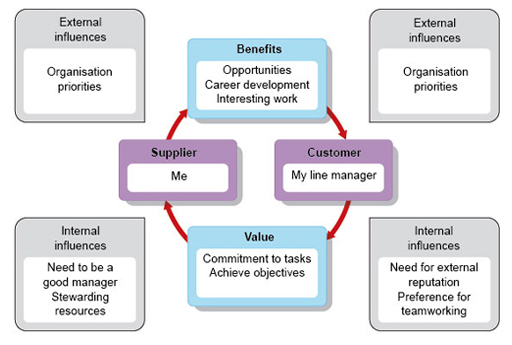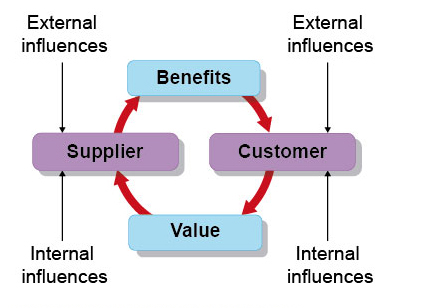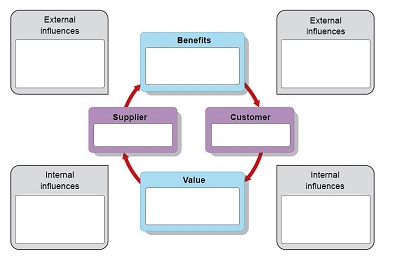1.4 Marketing as an exchange process
The idea of exchange is important when we come to think about customer behaviour. Bagozzi (1974) pioneered an approach to understanding marketing as an exchange process, see Figure 2 below, where a customer exchanges something of value, for example, money, with a supplier who is able to meet that customer’s needs, for example, with goods or services that solve a problem.
For an exchange to take place certain conditions must be met:
- There must be at least two parties.
- Each must have something that might be of value to the other.
- Each can communicate and deliver what they are offering.
- Each is free to accept or reject what is on offer.
- Each party trusts/respects the other sufficiently to take the exchange seriously.
Bagozzi originally thought in terms of commercial marketing, but later marketing theorists have applied this model to both commercial and non-commercial situations.
The value of this way of seeing marketing is that if you think hard enough about who is involved in the exchange, what is being exchanged, and what factors, internal and external, are influencing the exchange, you can predict and improve the outcomes of such exchanges. The study of customer behaviour therefore includes not only a focus on customers themselves, but on the many factors that influence how they behave.
Activity 3 Improving the outcome of an exchange
Select one of the customers you identified in the previous activity then fill in the interactive diagram of an exchange process below in relation to this customer. The following prompts might help you to add more detail:
- Who is the customer?
- What is being exchanged?
- What are the influences you can think of, internal and external, that affect the exchange?
Discussion
This discussion illustrates the activity with a personal example to which you can compare your own response. It is not meant to be a model answer, but it will offer you a different perspective that may help you learn more from the exercise. First, have a look at the completed diagram, and then read how the prompts were used to complete it.

I have chosen my line manager as my customer for this exercise.
What is being exchanged?My line manager offers me opportunities and in return I offer my commitment to the tasks involved. This happens in the framework of our paid employment in an organisation, but my manager has some discretion about what projects she gives me, and I have some choice about which to accept.
The benefits available to my line manager include being able to demonstrate she is managing resources to achieve organisational objectives for which she is accountable. The benefits to me are potential career development and the satisfaction of doing interesting and rewarding work.
What are the influences you can think of, internal and external, that affect the exchange?
Internal influences include our immediate priorities and preferences as individuals. My priorities include developing my reputation outside the organisation, so I actively seek projects that involve external partners. I also prefer working in teams as I enjoy learning from others and sharing ideas. My manager’s personal priorities include demonstrating that she is managing resources well, and developing her staff. In terms of preferences, I know from experience of working with her that she is very well-organised and appreciates this quality in others.
Turning to external influences, we are both employed by a university to achieve its objectives. This means the most important external influences on our internal marketing exchanges will be organisational priorities. These include creating relevant learning experiences that attract students and carrying out innovative research that attracts funding and has a positive social impact.
Can you think of a way in which a better understanding of your customer might enable both parties to get more out of the exchange?
In response to my manager’s preference for being well-organised, I can make an effort to improve my own organisational skills. This should make her more comfortable with me as a supplier and mean she has the confidence to offer me more interesting and complex projects.
Secondly, in response to external organisational pressures, I can make sure I am up to date with relevant plans and strategies in the university. This would give me more insight into what my manager needs to achieve and help us both do a better job to meet the needs of our final customers – learners and the various other customers (for example, businesses, voluntary organisations and government bodies).


